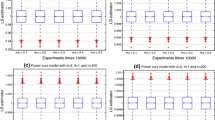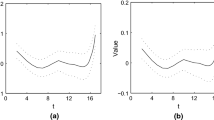Abstract
We consider the linear regression model with stochastic regressors and stochastic errors both in regressors and the dependent variable (“structural EIV model”), where the regressors and errors are assumed to satisfy some interesting and general conditions, different from traditional assumptions on EIV models (such as Deming regression). The most interesting fact is that we need neither independence of errors, nor identical distributions, nor zero means. The first main result is that the TLS estimator, where the traditional Frobenius norm is replaced by the Chebyshev norm, yields a consistent estimator of regression parameters under the assumptions summarized below. The second main result is that we design an algorithm for computation of the estimator, reducing the computation to a family of generalized linear-fractional programming problems (which are easily computable by interior point methods). The conditions under which our estimator works are (said roughly): it is known which regressors are affected by random errors and which are observed exactly; that the regressors satisfy a certain asymptotic regularity condition; all error distributions, both in regressors and in the endogenous variable, are bounded in absolute value by a common bound (but the bound is unknown and is estimated); there is a high probability that we observe a family of data points where the errors are close to the bound. We also generalize the method to the case that the bounds of errors in the dependent variable and regressors are not the same, but their ratios are known or estimable. The assumptions, under which our estimator works, cover many settings where the traditional TLS is inconsistent.








Similar content being viewed by others
Notes
A matrix norm \(\Vert \cdot \Vert \) is orthogonally invariant, if \(\Vert UAV\Vert =\Vert A\Vert \) for all \(A\in {\mathbb {R}}^{n\times p}\) and all unitary matrices \(U\in {\mathbb {R}}^{n\times n}\) and \(V\in {\mathbb {R}}^{p\times p}\).
A preliminary version of the algorithm for CNP, presented in Theorem 2, was reported at the ICCS’15 conference and is reported in the proceedings (Hladík and Černý 2015). It was studied there from the complexity-theoretic perspective. Here we present it with a proof for the reason that the geometry on which the algorithm is based will also be necessary for the proof of Theorem 1 and cannot be avoided. This paper is a follow-up of the mentioned conference contribution.
References
Almeida H, Campello M Jr, Galvao AF (2010) Measurement errors in investment equations. Rev Financial Stud 23:3279–3328
Bikel PJ, Ritov Y (1987) Efficient estimation of in the errors in variables model. Ann Stat 15:513–540
Biorn E (2010) Panel data with measurement errors: instrumental variables and GMM procedures combining levels and differences. Econom Rev 19:391–424
Carroll RJ, Ruppert D, Stefanski LA, Crainiceanu C (1997) Measurement error in nonlinear models: a modern perspective, 2nd edn. CRC, Boca Raton
Černý M, Hladík M (2014) The complexity of computation and approximation of the t-ratio over one-dimensional interval data. Comput Stat Data Anal 80:26–43
Chen H-Y, Lee A, Lee C-F (2015) Alternative errors-in-variables models and their applications in finance research. Quart Rev Econ Finance 58:213–227
Cheng CI, Van Ness JW (1999) Regression with measurement error. Oxford University Press, New York
Dagenais M, Dagenais D (1997) Higher moment estimators for linear regression models with errors in the variables. J Econom 76:193–222
Durbin J (1954) Errors in variables. Rev Int Stat Inst 22:23–32
Erickson T (2001) Constructing instruments for regressions with measurement error when no additional data are available: comment. Econometrica 69:221–222
Erickson T, Whited T (2002) Two-step GMM estimation of the errors-in-variables model using higher-order moments. Econom Theory 18:776–799
Erickson T, Jiang CH, Whited T (2014) Minimum distance estimation of the errors-in-variables model using linear cumulant equations. J Econom 183:211–221
Freund RW, Jarre F (1995) An interior-point method for multifractional programs with convex constraints. J Optim Theory Appl 85(1):125–161
Gallo PP (1982) Consistency of regression estimates when some variables are subject to error. Commun Stat Theory Methods 11:973–983
Gleser LJ (1981) Estimation in multivariate “errors in variables” regression models. Large sample results. Ann Stat 9:22–44
Golub GH, Van Loan CF (1980) An analysis of the total least squares problem. SIAM J Numer Anal 17:883–893
Golub GH, Hoffman A, Stewart GW (1987) A generalization of the Eckart-Young-Mirsky matrix approximation theorem. Linear Algebra Appl 88:322–327
Griliches Z, Hausman JA (1986) Errors in variables in panel data. J Econom 31:93–118
Healy JD (1975) Estimation and tests for unknown linear restrictions in multivariate linear models. PhD thesis, Purdue University
Hladík M, Černý M (2015) Total least squares and Chebyshev norm. Proced Comput Sci 51:1791–1800
Hladík M, Černý M (2017) Two optimization problems in linear regression with interval data. Optimization 66:331–349
Küchenhoff H (1995) The identification of logistic regression models with errors in the variables. Stat Pap 36(1):41–47
Kukush A, Van Huffel S (2004) Consistency of elementwise-weighted total least squares estimator in a multivariate errors-in-variables model AX=B. Metrika 59:75–97
Kukush A, Markovsky I, Van Huffel S (2002) On consistent estimators in linear and bilinear multivariate errors-in-variables models. In: Van Huffel S, Lemmerling P (eds) Total least squares and errors-in-variables modeling: analysis, algorithms and applications. SIAM, Philadelphia, pp 155–164
Kumunjer I, Ng S (2014) Measurement errors in dynamic models. Econom Theory 30:150–175
Lewbel A (1997) Constructing instruments for regressions with measurement error when no additional data are available, with an application to patents and R & D. Econometrica 65:1201–1213
Maddala GS, Nimalendran M (1996) Error-in-variables problems in financial models. In: Maddala GS, Rao CR (eds) Handbook of statistics. Elsevier Science, New York
Markovsky I, Rastellob ML, Premolic A, Kukush A, Van Huffel S (2005) The element-wise weighted total least-squares problem. Comput Stat Data Anal 50:181–209
Nesterov YE, Nemirovski AS (1995) An interior-point method for generalized linear-fractional programming. Math Program 69(1B):177–204
Oettli W, Prager W (1964) Compatibility of approximate solution of linear equations with given error bounds for coefficients and right-hand sides. Numerische Math 6:405–409
Okamoto M (1973) Distinctness of the eigenvalues of a quadratic form in a multivariate sample. Ann Stat 1:763–765
Pešta M (2011) Strongly consistent estimation in dependent errors-in-variables. AUC - Mathematica et Phys 52:69–79
Pešta M (2013a) Asymptotics for weakly dependent errors-in-variables. Kybernetika 49:692–704
Pešta M (2013b) Total least squares and bootstrapping with application in calibration. Stat J Theor Appl Stat 47:966–991
Pešta M (2016) Unitarily invariant errors-in-variables estimation. Stat Pap 57:1041–1057
Rao CR (1980) Matrix approximations and reduction of dimensionality in multivariate statistical analysis. In: Krishnaiah PR (ed) Multivariate analysis, vol 5. North-Holland, Amsterdam, pp 3–22
Shalabh Garg G, Misra N (2010) Consistent estimation of regression coefficients in ultrastructural measurement error model using stochastic prior information. Stat Pap 51(3):717–748
Singh S, Jain K, Sharma S (2014) Replicated measurement error model under exact linear restrictions. Stat Pap 55(2):253–274
Van Huffel S, Vandewalle J (1991) The total least squares problem: computational aspects and analysis. SIAM, Philadelphia
von Neumann J (1937) Some matrix inequalities and metrization of matric-space. Tomsk Univ Rev 1:286–300
Acknowledgements
The work was supported by the Czech Science Foundation under grants P402/13-10660S (M. Hladík), P402/12/G097 (M. Černý) and P403/15/09663S (J. Antoch). J. Antoch also acknowledges the support from the BELSPO IAP P7/06 StUDyS network. We are also obliged to Tomáš Cipra, a senior member of DYME Research Center, for fruitful discussions.
Author information
Authors and Affiliations
Corresponding author
Rights and permissions
About this article
Cite this article
Hladík, M., Černý, M. & Antoch, J. EIV regression with bounded errors in data: total ‘least squares’ with Chebyshev norm. Stat Papers 61, 279–301 (2020). https://doi.org/10.1007/s00362-017-0939-z
Received:
Revised:
Published:
Issue Date:
DOI: https://doi.org/10.1007/s00362-017-0939-z
Keywords
- Errors-in-variables
- Measurement error models
- Total least squares
- Chebyshev matrix norm
- Bounded error distributions
- Generalized linear-fractional programming




